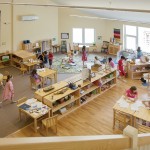If you are a teacher at an attractive school, and the local charters and other forms of school choice haven’t siphoned off a large chunk of your student body each year, your school is probably growing. In Arizona, and probably many places in the Southwest, we are used to growth in our communities and schools, though it doesn’t always happen. Growth, combined with stagnated and depleted educational funding, combine to create cramped quarters on campus. Administration and departmental leaders work hard to make sure that every student has a desk, and every teacher has a room.
However, there is often little choice but to share rooms, at least at the high school level where teachers have planning periods, and part-time instructors leave open classrooms for certain periods of the day.
This comes with savings in terms of buildings, but costs in terms of working conditions and time. Uncounted hours are spent shuffling teaching supplies, textbooks, classroom decor, furniture and technology. Most of this, I wager, is done off the clock over the summer. Then, during the school year, instead of connecting with students or monitoring the hallways during passing periods, running items to the copy room, or even using the restroom, the travelling teacher schleps her materials and herself back and forth, sometimes between buildings. I feel a sense of grief when I think about those classrooms plastered with photos of students and knick-knacky postcards and paraphernalia from the summer adventures of the teacher, signed posters from clubs and athletics teams sponsored and coached, student gifts, magnets, and random bumper stickers, those types of classrooms which are a dying breed in this environment. But perhaps this is just nostalgia.
However, despite the costs, perhaps there is a promise behind this sacrifice. I find that when I am sharing rooms or travelling, which I have had to do many a time over 19 years, I feel more connected with my colleagues. I have more adult conversations. I see more of what they teach, how they organize their classrooms and materials, how they greet students. This year at my school, by design many of the shared classrooms share a level in common– for instance my classroom is sophomores all day. 7 periods. There is a benefit to that. I see the vocabulary lists, the assignments, get a sense of the daily flow of a teacher who has been at this school much longer than I have. I see many possibilities developing.
Down the hall is the room where I will hold my reading strategies class each morning. We have organized it as a reading room, with posters designed to help inspire and reinforce basic skills, achievement charts, all our computers with headsets, a large table in the center for small group instruction, all the files that go along with our reading software, and fewer desks for the small classes that will be meeting there. My reading students will be scattered throughout my daily classes, but this is the nest where we will begin our day together. I look forward to them having that cozy home base.
Although I sometimes chafe against standardization pressing in on my instruction, and love my freedom as a teacher, I feel that sharing spaces helps support that elusive sense of shared purpose that schools are trying to create in their faculties and staff. Of course, I must admit I’m hesitant to write that, because I enjoy having my own little teacher-dom for all of my stuff. I would love to be in the same classroom for enough years to plaster the walls with photos and memorabilia and student projects. But that is not reality.
Many awkward compromises can come with unexpected benefits. Perhaps in certain settings it would actually be beneficial to consider shared spaces for specific academic needs, as we have for technology labs, libraries and sports. Perhaps middle and high school teachers need to loosen up their territorial boundaries a bit and see what lies beyond.










Comments 3
I’m glad you’ve been able to find the positive in the movement. I’ve been teaching for thirteen years and only had my own space for two of those years. In most cases I was the one with no home base moving into others’ classrooms during their plan periods.
One challenge we in my building encountered was the inequity in determining who moved, how many times they moved, and how far they had to move. I had one year where I moved after every period, and three of my four classrooms (I occupied the same room twice, though not consecutively) were not only in different wings of the school, but also on different floors. I’ve taught English in science classrooms, speech in the band room, and this year I’ll be teaching senior lit and comp in a Spanish classroom. I even had one colleague who, over the course of five periods, was actually assigned to six different classrooms, because his class would meet in one room on M, W, F, and another on T and Th. It creates chaos in the minds and briefcases of even the most organized teachers.
Rather than sharing rooms, I’d rather see schools innovate to share students…to team-teach, to collaborate in instruction not just in instructional space.
I hear you– I have seen a lot of inequity as well, and have definitely experienced the downsides. They stink. Beyond belief. I think I was just in a mood to look for a few positives there.
I really like your last point: it seems like in the 90’s and 2000’s people were willing to do what it took to create those teams and integrate instruction, and promise was beginning to show. But then budgets got so tight that master schedules got super-tight and the type of flexibility it took to maintain those programs went by the wayside in most places. I LOVED team teaching, but I see much less of it now than I did when I began teaching.
I have always held the traveling teacher in high regard and secretly saying “Thank God I have my own classroom.” However, you are so right when you talk about the adult relationships you have been able to create. There is not enough of this nor the collegiality you mention. Through it all you gain a better understanding of the students you all are teaching! Teaching, after all, when done well is the ultimate team sport! (OK, maybe it is not a sport but you get it!)